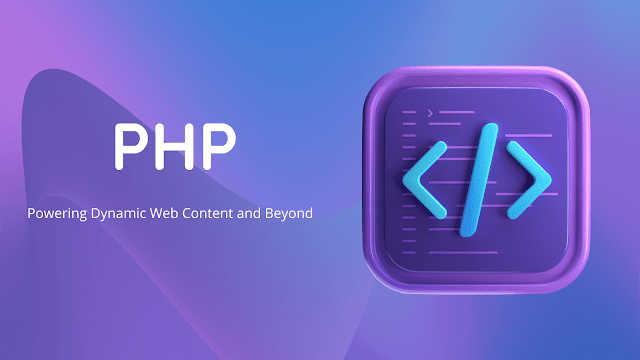PHP: Powering Dynamic Web Content and Beyond
PHP, originally an acronym for "Personal Home Page," has grown into a powerful and versatile scripting language that drives dynamic web content and a myriad of web applications. Developed by Rasmus Lerdorf in the mid-1990s, PHP has evolved from its humble beginnings into one of the most widely used languages on the web, powering websites ranging from simple blogs to enterprise-level applications. In this article, we explore the history, features, applications, and future prospects of PHP.
History and Evolution:
PHP was initially created by Rasmus Lerdorf in 1994 as a set of Common Gateway Interface (CGI) binaries written in C to track visits to his online resume. Over time, it evolved into a scripting language that enabled developers to embed dynamic content within HTML pages. The release of PHP 3 in 1998, featuring a redesigned language core and support for web forms, marked a significant milestone in PHP's development. Subsequent versions introduced improvements in performance, security, and functionality, culminating in PHP 7, which offered substantial performance enhancements and new language features.
Key Features and Strengths:
1. Simplicity and Ease of Use: PHP's syntax is intuitive and easy to learn, making it accessible to beginners while offering advanced features for experienced developers. Its resemblance to C, Java, and Perl simplifies the learning curve for those familiar with these languages.
2. Server-Side Scripting: PHP is primarily used for server-side scripting, allowing developers to generate dynamic web content by embedding PHP code within HTML pages. This enables the creation of interactive web applications that respond to user input and interact with databases and external services.
3. Wide Adoption and Community Support: PHP enjoys widespread adoption, powering over 75% of websites on the internet, including popular platforms like WordPress, Joomla, and Drupal. Its large and active community provides extensive documentation, tutorials, and third-party libraries, fostering collaboration and knowledge sharing.
4. Database Integration: PHP offers built-in support for various databases, including MySQL, PostgreSQL, and SQLite, allowing developers to easily connect to and manipulate database data within their applications. This seamless integration simplifies the development of dynamic web applications that rely on data persistence.
5. Platform Independence: PHP is platform-independent, running on all major operating systems, including Windows, macOS, and Linux. This ensures compatibility and portability across different environments, facilitating deployment and maintenance.
Applications of PHP:
1. Content Management Systems (CMS): PHP powers numerous CMS platforms, such as WordPress, Joomla, and Drupal, which enable users to create, manage, and publish digital content without extensive technical expertise. These platforms leverage PHP's flexibility and extensibility to support a wide range of use cases, from blogs and e-commerce sites to corporate portals and online communities.
2. E-commerce Solutions: PHP is widely used in the development of e-commerce solutions, including shopping carts, payment gateways, and inventory management systems. Platforms like Magento and WooCommerce leverage PHP to provide robust, customizable e-commerce experiences for businesses of all sizes.
3. Web Application Development: PHP is well-suited for building web applications, ranging from simple CRUD (Create, Read, Update, Delete) applications to complex enterprise solutions. Frameworks like Laravel, Symfony, and CodeIgniter offer tools and conventions to streamline development, improve code organization, and enhance security.
4. API Development: PHP can be used to develop RESTful APIs (Application Programming Interfaces) that allow applications to communicate and exchange data over the web. APIs built with PHP serve as the backbone for mobile apps, web services, and integrations with third-party platforms.
5. Command-Line Scripting: PHP is not limited to web development; it can also be used for command-line scripting tasks, such as automation, data processing, and system administration. Its versatility makes it a valuable tool for developers who need to perform batch operations or create custom utilities.
Future Trends and Challenges:
As technology continues to evolve, PHP faces both opportunities and challenges in staying relevant and competitive. Key trends shaping the future of PHP include:
1. Performance Optimization: With the release of PHP 8 and ongoing efforts to improve performance and memory efficiency, PHP aims to maintain its competitive edge in the face of emerging languages and platforms.
2. Modernization and Tooling: PHP is adapting to modern development practices and tooling, with the adoption of package managers like Composer, dependency injection containers, and automated testing frameworks to enhance code quality and developer productivity.
3. Security and Best Practices: PHP continues to address security concerns through features like the built-in filter extension for input validation, secure coding guidelines, and regular security updates. However, developers must remain vigilant and follow best practices to mitigate security risks and protect against vulnerabilities.
4. Microservices and Cloud Native Development: As organizations embrace microservices architecture and cloud-native development practices, PHP frameworks and tools are evolving to support these paradigms, enabling developers to build scalable, resilient, and cloud-ready applications.
conclusion
In conclusion, PHP remains a cornerstone of web development, powering a vast ecosystem of websites, applications, and services on the internet. Its simplicity, versatility, and extensive community support have contributed to its enduring popularity and continued relevance in an ever-changing digital landscape. As PHP evolves to meet the demands of modern web development, it remains a compelling choice for developers seeking to build dynamic, interactive, and scalable web solutions.

